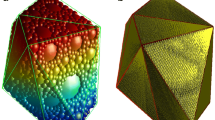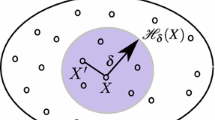Abstract
In the simulation of discontinuous block systems, the discrete element method (DEM) has better computational efficiency and convergence than the finite element method (FEM). When several DEM particles are bonded together with parallel bonds (the bonded particle model, BPM), various shapes and block fractures can be simulated. The main aim of the BPM is to simulate a continuous material in which the stress distribution is continuous. Since the existing stress result for a single particle is an average value over the particle’s area, stress results do not exist in the area between particles. In this paper, the stress value for a single two-dimensional DEM particle is deduced. A stress recovery procedure with a linear stress function for a triangular element generated by the centroids of three bonded particles is proposed. In this way, the recovered stress field for the whole mesh composed of all triangular elements is continuous. A stress gradient exists in the whole mesh. This can also provide more accurate stress values for judging a fracture inside a block. Symmetrical and asymmetrical models are simulated by the BPM and FEM. Similar to the FEM results, the recovered stress results for the BPM can describe the stress distribution in the simulated continuous blocks. For the model with the theoretical stress solution, the recovered result and the theoretical solution coincide well.




Similar content being viewed by others
References
Cundall PA, Strack ODL. A discrete numerical model for granular assemblies. Géotechnique. 1979;29(1):47–65.
Ma G, Zhou W, Chang XL. Modeling the particle breakage of rockfill materials with the cohesive crack model. Comput Geotech. 2014;61:132–43.
Lobo-Guerrero S, Vallejo LE. Discrete element method analysis of railtrack ballast degradation during cyclic loading. Granul Matter. 2006;8:195–204.
Zhou W, Yang L, Ma G, et al. DEM analysis of the size effects on the behavior of crushable granular materials. Granul Matter. 2016;18(3):1–11.
Shi GH. Discontinuous deformation analysis: a new numerical model for the statics and dynamics of block system [PhD thesis]. Berkeley, California: Univ CalifBerkeley; 1988.
Potyondy DO, Cundall PA. A bonded-particle model for rock. Int J Rock Mech Min Sci. 2004;41(7):1329–64.
Cheng Y P, Bolton MD, Nakata Y. Grain crushing and critical states observed in DEM simulations. In: Proceedings of the 5th international conference on micromecnanics of granular media, vol. 2. Stuttgart, 2005; p. 1393–7.
Lim WL, Mcdowell GR. Discrete element modelling of railway ballast. Granul Matter. 2005;7(1):19–29.
Bolton MD, Nakata Y, Cheng YP. Micro-and macro-mechanical behaviour of DEM crushable materials. Géotechnique. 2008;58(6):471–80.
Wang J, Yan H. On the role of particle breakage in the shear failure behavior of granular soils by DEM. Int J Numer Anal Methods Geomech. 2013;37(8):832–54.
Cil MB, Alshibli KA. 3D evolution of sand fracture under 1D compression. Géotechnique. 2014;64(5):351–64.
Cil MB, Alshibli KA. 3D assessment of fracture of sand particles using discrete element method. Géotech Lett. 2012;2(3):161–6.
Zhang XP, Wong LNY. Crack initiation, propagation and coalescence in rock-like material containing two flaws: a numerical study based on bonded-particle model approach. Rock Mech Rock Eng. 2013;46:1001–21.
Zhang XP, Liu Q, Wu S, et al. Crack coalescence between two non-parallel flaws in rock-like material under uniaxial compression. Eng Geol. 2015;199:74–90.
Zhang XP, Zhang Q, Wu S. Acoustic emission characteristics of the rock-like material containing a single flaw under different compressive loading rates. Comput Geotech. 2017;83:83–97.
Åström JA, Herrmann HJ. Fragmentation of grains in a two-dimensional packing. Phys Condens Matter. 1998;5(3):551–4.
Tsoungui O, Vallet D, Charmet JC. Numerical model of crushing of grains inside two-dimensional granular materials. Powder Technol. 1999;105(1):190–8.
Brosh T, Kalman H, Levy A. Fragments spawning and interaction models for DEM breakage simulation. Granul Matter. 2011;13(6):765–76.
Ben-Nun O, Einav I. A refined DEM study of grain size reduction in uniaxial compression. In: Proceedings of the 12th international conference of the international association for computer methods and advances in geomechanics (IACMAG), Goa, 2008. p. 702–8.
De Bono JP, Mcdowell GR. DEM of triaxial tests on crushable sand. Granul Matter. 2014;16(4):551–62.
Christoffersen J, Mehrabadi MM, Nemat-Nasser S. A micromechanical description of granular material behavior. J Appl Mech. 1981;48(2):339.
Bagi K. Stress and strain in granular assemblies. Mech Mater. 1996;22(3):165–77.
Bramble JH, Schatz AH. High order local accuracy by averaging in the finite element method. Math Comput. 1977;31:94–111.
Hinton E, Campbell JS. Local and global smoothing of discontinuous finite element functions using a least-square method. Int J Numer Methods Eng. 1974;8:461–80.
Silva RCC, Loula AF, Guerreiro JNC. Local gradient and stress recovery for triangular elements. Comput Struct. 2004;82:2083–92.
Heimsund BO, Tai XC, Wang J. Superconvergence for the gradients of finite element approximations by L2 projections. SIAM J Numer Anal. 2000;40:1263–80.
Zhu JZ, Zienkiewicz OC. Superconvergence recovery technique and a posteriori error estimators. Int J Numer Methods Eng. 1990;30:1321–39.
Zienkiewicz OC, Zhu JZ. The superconvergent patch recovery and a posteriori error estimates. Part 1: the recovery technique. Int J Numer Methods Eng. 1992;33:1331–64.
Stein E, Ahmad R. On the stress computation in finite element models based upon displacement approximations. Comput Methods Appl Mech Eng. 1974;4:81–96.
Boroomand B, Zienkiewicz OC. Recovery by equilibrium patches. Int J Numer Methods Eng. 1997;40:137–64.
Zhao Z, Gu J. Stress recovery procedure for discontinuous deformation analysis. Adv Eng Softw. 2009;40:52–7.
Guan R, Bie S. Contact-stress-based stress recovery methods for discontinuous deformation analysis. Acta Mech Solida Sin. 2020;33:508–20.
Li S, He T, Yin X. Introduction of rock fracture mechanics. Hefei: USTC Press; 2010.
Wu J. Theory of elasticity. Shanghai: Tongji Press; 1987.
Acknowledgements
This research did not receive any specific grant from funding agencies in the public, commercial, or not-for-profit sectors.
Author information
Authors and Affiliations
Contributions
RG contributed to conceptualization and methodology. SB helped with supervision. CC contributed to software and investigation.
Corresponding author
Ethics declarations
Conflicts of interest
No conflict of interest exists in the submission of this manuscript.
Availability of data and materials
The datasets used or analyzed during the current study are available from the corresponding author on reasonable request.
Code Availability
The code used during the current study is available from the corresponding author on reasonable request.
Rights and permissions
About this article
Cite this article
Guan, R., Bie, S. & Chen, C. Stress Recovery Procedure for the Bonded Particle Model. Acta Mech. Solida Sin. 34, 356–368 (2021). https://doi.org/10.1007/s10338-020-00206-8
Received:
Revised:
Accepted:
Published:
Issue Date:
DOI: https://doi.org/10.1007/s10338-020-00206-8




